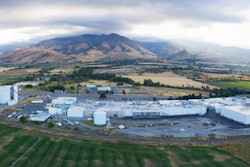Of the challenges that food and beverage manufacturers face today, the one that often tops the list is labor—namely, the availability of labor to keep production running. At PACK EXPO Las Vegas, Reading Bakery Systems presented a scenario for bakers to get a leg up on the situation, moving toward a lights-out mixing room.
So named because an operation that requires no people also requires no lights, lights-out manufacturing is a concept that has been tested in a variety of industries. In the case presented by Exact Mixing, part of Reading Bakery Systems, a near lights-out scenario—requiring only 5 minutes of an employee’s time per hour—saved a major cookie manufacturer close to $325,000 per year in labor.
That money saved goes a long way to getting payback on what is admittedly a high upfront cost in automated systems. But the real win is the ability to keep production going at needed rates amid a worsening labor situation. Presenting the case for lights-out mixing on the Processing Innovation Stage, Jim Warren, vice president of Exact Mixing, highlighted the changing times in the workforce.
“Since the advent of COVID, the workforce has become smaller. But in addition to that, the expectations of employees have changed,” he says, pointing to a list of the top 10 goals of today’s potential employees, including work from home, higher pay, improved benefits, more vacation time, quick advancement, flexible work hours, etc. “The difficulty in the bakery world is that other businesses might be better suited to offer things like the opportunity to work from home, flexible hours, and more vacation time.”
Lights-out manufacturing offers an opportunity to overcome those issues. “While most industries are not prepared for lights-out manufacturing front to back, continuous mixture offers the opportunity to operate lights-out in the mixing room,” Warren says.
The cookie case
With the leading cookie maker as an example, Warren detailed how the processor needed to boost production of its cookie dough to meet demand. The current process, using two batch mixers, was supplying 3,000 lb of dough an hour to the line. The new process, however, would have to supply 6,000 lb/hr.
“The company decided to implement a near lights-out mixing process in the mixing room,” Warren says. “The results certainly exceeded their expectations.”
Using automated continuous mixing, the cookie maker was able to reach its goal of 6,000 lb/hr with just one mixer, no dedicated employees, and just 5 total minutes of labor per hour. “The line basically runs itself, so 5 minutes an hour would be for someone to occasionally look at the screen or to answer an alarm if one were sounded by the mixing system,” Warren says.
Previously, handling the two batch mixers and materials required three dedicated employees, totaling 135 minutes of labor an hour. To show the difference in labor minutes required, Warren breaks the mixing process down into four key steps:
- Materials Delivery: Although flour delivery is automated in both the batch and continuous process, minors are delivered by forklift to the batch mixers while minor delivery for continuous process is also automated.
- Ingredient Dosing: Again, the flour dosing is automated for the batch process, but minors are added by one operator per mixer. The continuous process is automated with loss-in-weight (LIW) feeders, mass flow liquids, and mass flow fat.
- Mixing: Mixing happens in stages for the batch process, with operators stopping the mixers to add minors between stages. “The mixer operators would have to stop the mixer four or five times during the mixing process to hand weigh and add additional minors, certainly offering the opportunity first for errors, and secondly, it required a great deal of training before someone was capable of properly operating the mixer,” Warren says. For continuous process, mixing is fully automated.
- Dough Discharge: With the batch process, an operator tilts the bowl to discharge the dough into a hopper. Discharge is automated in continuous process, cutting the dough into 25-lb pieces, which would fall onto a conveyor to be taken to a hopper or the forming equipment. “In the case of the batch mixer, you were simply making pieces of dough that were too large to go into the hopper or forming equipment,” Warren explains. “So, when the dough came out, the dough had to be resized.”
Again, the upfront cost for such an automated system is considerable, costing in some cases as much as double a typical batch mixing system. But in this case, payback took less than a year while the cookie manufacturer was able to double its output.
“A lights-out mixing operation can solve your labor challenges while improving your product quality and consistency,” Warren says. “While you experience a higher initial investment, payback will likely be short and future savings will be significant.”























